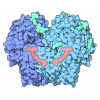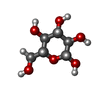+ データを開く
データを開く
- 基本情報
基本情報
| 登録情報 | データベース: PDB / ID: 8vbb | ||||||||||||||||||||||||
|---|---|---|---|---|---|---|---|---|---|---|---|---|---|---|---|---|---|---|---|---|---|---|---|---|---|
| タイトル | The secreted adhesin EtpA of Enterotoxigenic Escherichia coli in complex with the mouse mAb 1G05 | ||||||||||||||||||||||||
 要素 要素 |
| ||||||||||||||||||||||||
 キーワード キーワード | CELL ADHESION / Adhesin / glycoprotein / lectin / antibody-antigen complex | ||||||||||||||||||||||||
| 機能・相同性 |  機能・相同性情報 機能・相同性情報adhesion of symbiont to host cell surface via host membrane carbohydrate / extracellular region 類似検索 - 分子機能 | ||||||||||||||||||||||||
| 生物種 |   | ||||||||||||||||||||||||
| 手法 | 電子顕微鏡法 / 単粒子再構成法 / クライオ電子顕微鏡法 / 解像度: 3.97 Å | ||||||||||||||||||||||||
 データ登録者 データ登録者 | Berndsen, Z.T. / Ward, A.B. | ||||||||||||||||||||||||
| 資金援助 |  米国, 7件 米国, 7件
| ||||||||||||||||||||||||
 引用 引用 |  ジャーナル: PLoS Pathog / 年: 2024 ジャーナル: PLoS Pathog / 年: 2024タイトル: Repeat modules and N-linked glycans define structure and antigenicity of a critical enterotoxigenic E. coli adhesin. 著者: Zachary T Berndsen / Marjahan Akhtar / Mahima Thapa / Tim J Vickers / Aaron Schmitz / Jonathan L Torres / Sabyasachi Baboo / Pardeep Kumar / Nazia Khatoon / Alaullah Sheikh / Melissa Hamrick ...著者: Zachary T Berndsen / Marjahan Akhtar / Mahima Thapa / Tim J Vickers / Aaron Schmitz / Jonathan L Torres / Sabyasachi Baboo / Pardeep Kumar / Nazia Khatoon / Alaullah Sheikh / Melissa Hamrick / Jolene K Diedrich / Salvador Martinez-Bartolome / Patrick T Garrett / John R Yates / Jackson S Turner / Renee M Laird / Frédéric Poly / Chad K Porter / Jeffrey Copps / Ali H Ellebedy / Andrew B Ward / James M Fleckenstein /  要旨: Enterotoxigenic Escherichia coli (ETEC) cause hundreds of millions of cases of infectious diarrhea annually, predominantly in children from low-middle income regions. Notably, in children, as well as ...Enterotoxigenic Escherichia coli (ETEC) cause hundreds of millions of cases of infectious diarrhea annually, predominantly in children from low-middle income regions. Notably, in children, as well as volunteers challenged with ETEC, diarrheal severity is significantly increased in blood group A (bgA) individuals. EtpA, is a secreted glycoprotein adhesin that functions as a blood group A lectin to promote critical interactions between ETEC and blood group A glycans on intestinal epithelia for effective bacterial adhesion and toxin delivery. EtpA is highly immunogenic resulting in robust antibody responses following natural infection and experimental challenge of volunteers with ETEC. To understand how EtpA directs ETEC-blood group A interactions and stimulates adaptive immunity, we mutated EtpA, mapped its glycosylation by mass-spectrometry (MS), isolated polyclonal (pAbs) and monoclonal antibodies (mAbs) from vaccinated mice and ETEC-infected volunteers, and determined structures of antibody-EtpA complexes by cryo-electron microscopy. Both bgA and mAbs that inhibited EtpA-bgA interactions and ETEC adhesion, bound to the C-terminal repeat domain highlighting this region as crucial for ETEC pathogen-host interaction. MS analysis uncovered extensive and heterogeneous N-linked glycosylation of EtpA and cryo-EM structures revealed that mAbs directly engage these unique glycan containing epitopes. Finally, electron microscopy-based polyclonal epitope mapping revealed antibodies targeting numerous distinct epitopes on N and C-terminal domains, suggesting that EtpA vaccination generates responses against neutralizing and decoy regions of the molecule. Collectively, we anticipate that these data will inform our general understanding of pathogen-host glycan interactions and adaptive immunity relevant to rational vaccine subunit design. | ||||||||||||||||||||||||
| 履歴 |
|
- 構造の表示
構造の表示
| 構造ビューア | 分子:  Molmil Molmil Jmol/JSmol Jmol/JSmol |
|---|
- ダウンロードとリンク
ダウンロードとリンク
- ダウンロード
ダウンロード
| PDBx/mmCIF形式 |  8vbb.cif.gz 8vbb.cif.gz | 245.7 KB | 表示 |  PDBx/mmCIF形式 PDBx/mmCIF形式 |
|---|---|---|---|---|
| PDB形式 |  pdb8vbb.ent.gz pdb8vbb.ent.gz | 表示 |  PDB形式 PDB形式 | |
| PDBx/mmJSON形式 |  8vbb.json.gz 8vbb.json.gz | ツリー表示 |  PDBx/mmJSON形式 PDBx/mmJSON形式 | |
| その他 |  その他のダウンロード その他のダウンロード |
-検証レポート
| 文書・要旨 |  8vbb_validation.pdf.gz 8vbb_validation.pdf.gz | 1.9 MB | 表示 |  wwPDB検証レポート wwPDB検証レポート |
|---|---|---|---|---|
| 文書・詳細版 |  8vbb_full_validation.pdf.gz 8vbb_full_validation.pdf.gz | 1.9 MB | 表示 | |
| XML形式データ |  8vbb_validation.xml.gz 8vbb_validation.xml.gz | 66.6 KB | 表示 | |
| CIF形式データ |  8vbb_validation.cif.gz 8vbb_validation.cif.gz | 97.4 KB | 表示 | |
| アーカイブディレクトリ |  https://data.pdbj.org/pub/pdb/validation_reports/vb/8vbb https://data.pdbj.org/pub/pdb/validation_reports/vb/8vbb ftp://data.pdbj.org/pub/pdb/validation_reports/vb/8vbb ftp://data.pdbj.org/pub/pdb/validation_reports/vb/8vbb | HTTPS FTP |
-関連構造データ
| 関連構造データ |  43119MC M: このデータのモデリングに利用したマップデータ C: 同じ文献を引用 ( |
|---|---|
| 類似構造データ | 類似検索 - 機能・相同性  F&H 検索 F&H 検索 |
- リンク
リンク
- 集合体
集合体
| 登録構造単位 | 
|
|---|---|
| 1 |
|
- 要素
要素
| #1: タンパク質 | 分子量: 157456.922 Da / 分子数: 1 / 由来タイプ: 組換発現 由来: (組換発現)  遺伝子: etpA / 発現宿主:  | ||||
|---|---|---|---|---|---|
| #2: 抗体 | 分子量: 51428.785 Da / 分子数: 1 / 由来タイプ: 組換発現 / 由来: (組換発現)   Homo sapiens (ヒト) Homo sapiens (ヒト) | ||||
| #3: 抗体 | 分子量: 25413.287 Da / 分子数: 1 / 由来タイプ: 組換発現 / 由来: (組換発現)   Homo sapiens (ヒト) Homo sapiens (ヒト) | ||||
| #4: 糖 | ChemComp-BGC / 研究の焦点であるリガンドがあるか | Y | Has protein modification | Y | |
-実験情報
-実験
| 実験 | 手法: 電子顕微鏡法 |
|---|---|
| EM実験 | 試料の集合状態: PARTICLE / 3次元再構成法: 単粒子再構成法 |
- 試料調製
試料調製
| 構成要素 | 名称: EtpA in complex with the mAb 1G05 Fab / タイプ: COMPLEX / Entity ID: #1-#3 / 由来: RECOMBINANT |
|---|---|
| 分子量 | 値: .220 MDa / 実験値: YES |
| 由来(天然) | 生物種:  |
| 由来(組換発現) | 生物種:  |
| 緩衝液 | pH: 6 |
| 試料 | 濃度: 1 mg/ml / 包埋: NO / シャドウイング: NO / 染色: NO / 凍結: YES |
| 急速凍結 | 装置: FEI VITROBOT MARK IV / 凍結剤: ETHANE / 湿度: 100 % / 凍結前の試料温度: 277.15 K |
- 電子顕微鏡撮影
電子顕微鏡撮影
| 顕微鏡 | モデル: TFS GLACIOS |
|---|---|
| 電子銃 | 電子線源:  FIELD EMISSION GUN / 加速電圧: 200 kV / 照射モード: FLOOD BEAM FIELD EMISSION GUN / 加速電圧: 200 kV / 照射モード: FLOOD BEAM |
| 電子レンズ | モード: BRIGHT FIELD / 最大 デフォーカス(公称値): 1500 nm / 最小 デフォーカス(公称値): 500 nm / アライメント法: COMA FREE |
| 試料ホルダ | 凍結剤: NITROGEN 試料ホルダーモデル: FEI TITAN KRIOS AUTOGRID HOLDER |
| 撮影 | 電子線照射量: 47 e/Å2 フィルム・検出器のモデル: TFS FALCON 4i (4k x 4k) |
- 解析
解析
| EMソフトウェア |
| ||||||||||||||||||||||||||||||||||||||||
|---|---|---|---|---|---|---|---|---|---|---|---|---|---|---|---|---|---|---|---|---|---|---|---|---|---|---|---|---|---|---|---|---|---|---|---|---|---|---|---|---|---|
| CTF補正 | タイプ: PHASE FLIPPING AND AMPLITUDE CORRECTION | ||||||||||||||||||||||||||||||||||||||||
| 3次元再構成 | 解像度: 3.97 Å / 解像度の算出法: FSC 0.143 CUT-OFF / 粒子像の数: 52107 / 対称性のタイプ: POINT | ||||||||||||||||||||||||||||||||||||||||
| 原子モデル構築 | プロトコル: FLEXIBLE FIT / 空間: REAL | ||||||||||||||||||||||||||||||||||||||||
| 原子モデル構築 | Source name: AlphaFold / タイプ: in silico model | ||||||||||||||||||||||||||||||||||||||||
| 拘束条件 |
|
 ムービー
ムービー コントローラー
コントローラー



 PDBj
PDBj






